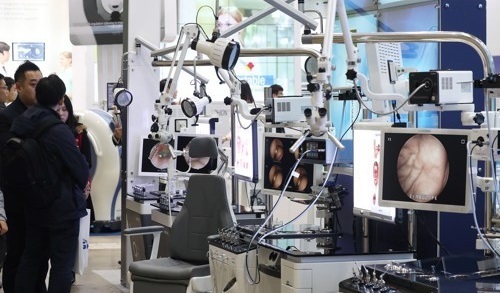South Korea's preventable death rate has dropped dramatically over the past decade due to improvements in the public health care system, a report showed Wednesday.
Avoidable mortality means deaths that could have been potentially prevented with the help of the right medical infrastructure and treatment.
 |
Visitors look at the latest medical equipment displayed at the Korea International Medical Clinical Laboratories and Hospital Equipment Show held at the Convention and Exhibition Center in Seoul on March 16, 2017. (Yonhap) |
The number of deaths that could have been prevented dropped 44.44 percent to 46.5 out of every 100,000 people in 2014 from 83.7 in 2005, according to the report by the Korea Institute for Health and Social Affairs.
By region, the southeastern port city of Busan recorded the highest avoidable death rate at 54.1 in 2014, down from 100.4 in 2005.
Gangwon Province had the second highest rate at 54, followed by Daegu at 53.2 and North Gyeongsang Province at 52.7. Incheon followed suit at 51.9 and North Chungcheong Province at 51.3.
Daejeon had the lowest numbers at 38.4 with Jeju Island trailing at 39.8 and Seoul placing third lowest at 40.1.
Other regions in the country, such as the industrial city of Ulsan and Gyeonggi Province around the capital city, reported numbers in the mid-40s, with the Jeolla region posting numbers around 50, the public institute said. (Yonhap)





![[Exclusive] Hyundai Mobis eyes closer ties with BYD](http://res.heraldm.com/phpwas/restmb_idxmake.php?idx=644&simg=/content/image/2024/11/25/20241125050044_0.jpg)
![[Herald Review] 'Gangnam B-Side' combines social realism with masterful suspense, performance](http://res.heraldm.com/phpwas/restmb_idxmake.php?idx=644&simg=/content/image/2024/11/25/20241125050072_0.jpg)

